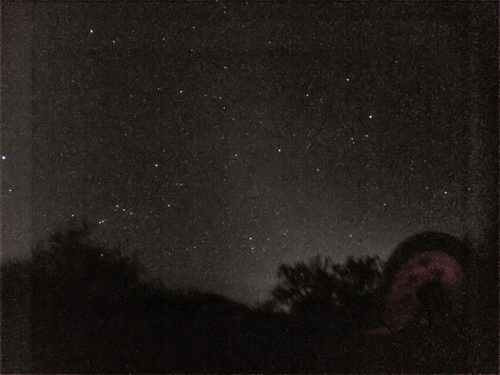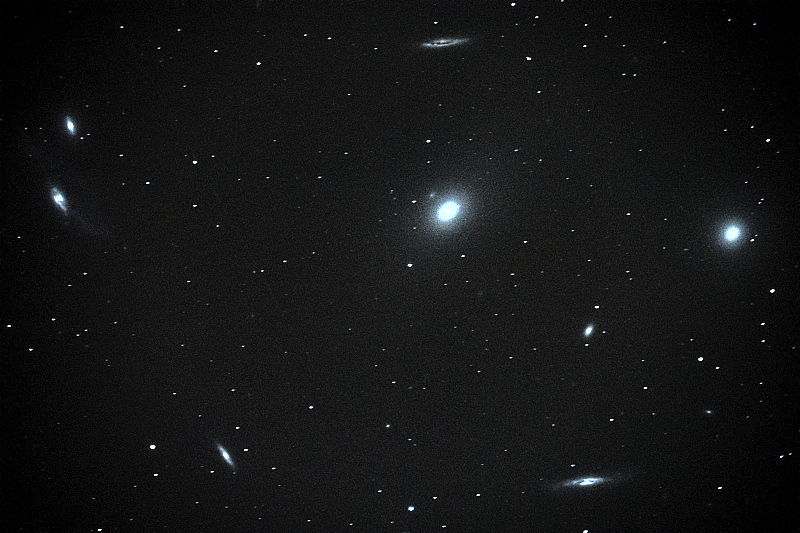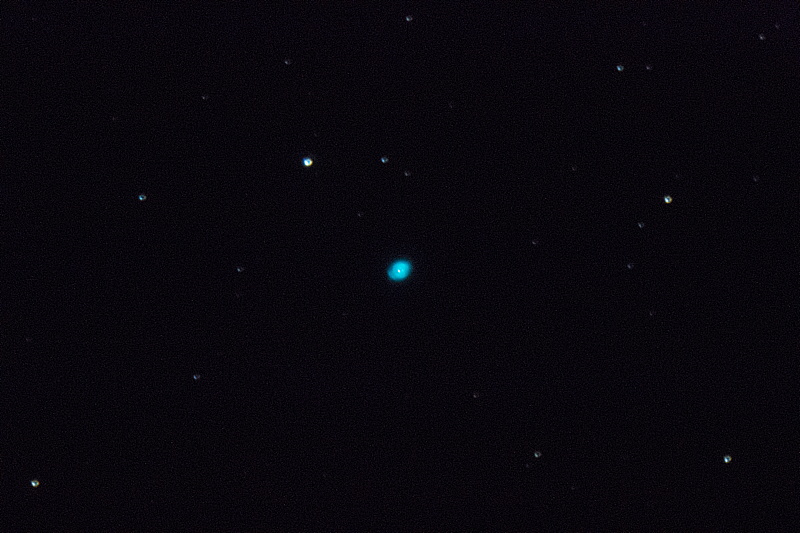iPhone & SkyTracker Pro Orion, Zodiacal Light;
DSLR Virgo Galaxies, Cat's Eye Nebula
Posted: 22 April 2017
|
Open: Friday, 21 April 2017, 1841 MST Temperature: 90°F |
Session: 1103 Conditions: Clear, breezy |
Equipment Used:
12" f/8 LX600 w/StarLock
2" 24mm UWA eyepiece
2" 2X PowerMate
SkyTracker Pro
Camera:
iPhone 6s Plus
D7200 DSLR
As I had dome on the previous session, I brought out the iOptron SkyTracker Pro. The previous session used the DSLR to photograph the Zodiacal Light. This night I would use the iPhone to try to photograph the Zodiacal Light. I would also try a photograph of Orion using a clip-on 8X telephoto lens.
1900 MST: sunset. I then began enjoying "watching the stars come out" from the observatory patio bench. 1915 MST: it was calm now.
1945 MST: began preparing to image Orion with the iPhone 6s Plus + 8X telephoto lens. Mounted the iPhone on the SkyTracker Pro, then polar aligned the SkyTracker Pro. This is the rig:

Using the iOS app NightCap Camera (formerly NightCap Pro) I took this photo of Orion's Belt and Sword with the Great Orion Nebula (M42) in the belt, Long Exposure, Light Boost, ISO 8000, 1/3sec, 5 minutes:

I switched to a clip-on wide-angle lens:

Using a 1/2X Sidereal tracking rate on the SkyTracker Pro I took this NightCap Camera image, Long Exposure, Light Boost, ISO 8000, 1/3sec, 5 minutes:

The constellation of Orion is above the tree on the left, Hyades just below center, the Pleiades just above the tree near the center, and the constellation of Auriga above it. The observatory dome is in the lower right corner. A portion of the Zodiacal Light is faintly visible near the Hyades and Pleiades.
With a 1X Sidereal tracking rate on the SkyTracker Pro the stars are sharper and the Zodiacal Light a little better in this NightCap Camera image, Long Exposure, Light Boost, ISO 8000, 1/3sec, 5 minutes:

2039 MST: while I was taking the above image of the western sky a very bright meteor appeared passing through the constellation of Perseus. It was brighter than the planet Jupiter. Unfortunately, it was just out of the camera field-of-view to the right.
2047 MST: ended Zodiacal Light imaging. Took a short break. 2058 MST: returned to the observatory.
2059 MST: LX600 ON, StarLock OFF, High Precision OFF. Viewed Jupiter, 102X. Visible in the eyepiece were the four Galilean Moons, the Great Red Spot, and the shadow of the moon Ganymede in transit.
I then began preparing to re-image some galaxies in the Virgo Cluster of Galaxies. Moved the dome OFF to the PZT. Mounted the D7200 DSLR at prime focus + focal reducer, focused on the star Denebola, locked the primary mirror, then slewed to the galaxy M86. 2119 MST: StarLock ON.
I did some 1 minute, ISO 6400, White Balance 3570K, framing test images. The breezes began blowing again. As I was doing these test images I could see that, as on the previous session, seeing was not very good and autoguiding was not very accurate. I decided to forget about doing any long exposures and did several 1 minute exposures to stack. However, autoguiding was good enough on only three images. These were stacked for this effective 3 minute exposure:

Mouseover or tap on image labels
I will try again for a longer exposure on a future session.
2156 MST: StarLock OFF. Removed the camera. Dome ON.
2207 MST: viewed NGC6543 (Cat's Eye Nebula, planetary nebula), 102X. Added the 2X PowerMate for a view at 203X. SYNCed on NGC6543, then slewed to the star Kocab, mounted the DSLR at prime focus + 2X PowerMate, focused, and locked the mirror. Went back to NGC6543 for this image of the Cat's Eye Nebula, 30 seconds, ISO 6400, WB 3570K:

Unfortunately, the focus shifted slightly so the image is slightly out-of-focus.
2230 MST: ended imaging.
Viewed Jupiter, 102X and 203X. The Great Red Spot was still visible. Then slewed to the star Spica and SYNCed the AutoStar to be ready for the next night's session. 2247 MST: LX600 OFF.
|
Close: Friday, 21 April 2017, 2256 MST Temperature: 63°F |
Session Length: 4h 15m Conditions: Clear, breezy |
Comments are welcome using Email. Twitter users can use the button below to tweet this report to your followers. Thanks.
Cassiopeia Observatory Home Page
Copyright ©2017 Michael L. Weasner / mweasner@me.com
URL = http://www.weasner.com/co/Reports/2017/04/22/index.html
